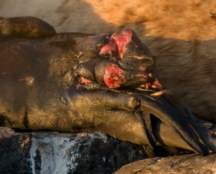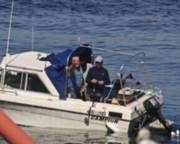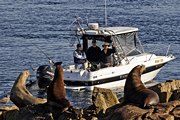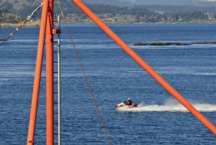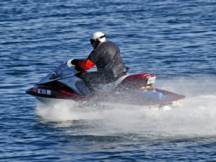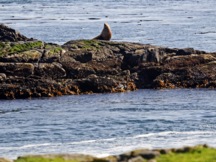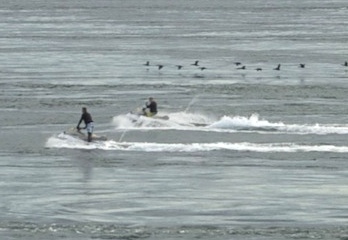| Whether or not you consider marine mammals to be a valuable part of an ecosystem, we have the unique opportunity of having an island close to a major centre of population which is a haulout habitat for five marine mammal species and a birthing habitat for three of those species. This is unique in Canada, and it is our responsibility to maintain that ecological integrity of the location as much as possible. The purpose of the ecological reserve is to protect as far as possible the entire ecosystem, including the seabirds, mammals, marine invertebrates, fish and algae. |
| Below we have some examples of the results of what we might call “Anthropogenic” or human caused disturbances from encounters of animals with motor boats. These are only the ones we see and document. No one knows what goes undocumented. Safe boating practises and speed reduction are needed in all areas around bird and mammal colonies. Regulations for all boaters within the reserve can be found in the regulations file. |
| In this video, you can see the results of what a motor boat can do when driven over an elephant seal. Male Elephant Seal Injured by BOAT propeller –January 2003 |
his file provides evidence of what can happen when boaters do not exercise caution. Over the years, we have picked up several baby harbour seals at Race Rocks which have been decapitated by careless boaters. The most recent ones in Pedder Bay are documented here also. | Regular observation and photographing of sea lions in 2009 has shown a number of horrendous injuries which are probably caused by collision with boat propellers. This file documents a number of those. |
Often the greatest ignorance about marine mammal viewing regulations is illustrated by the actions of recreational boaters. Such infractions of the laws are forwarded to the DFO Marine Mammal Division for follow-up.
Infractions noted in the log are linked here:
The Problem with Drones
So far we have only had one instance of a drone being deployed over Race Rocks by a private boat in August, 2015. We would like to remind the public that because of the potential to disrupt wildlife, the only justification for deploying a drone in any Ecological Reserve would be for research purposes and then only under permit from BC Parks,
The Problem with Personal Watercraft
 DEMARCHI, MW AND MD BENTLEY. 2004. Effects of natural and human-caused disturbances on marine birds and pinnipeds at Race Rocks, British Columbia. DEMARCHI, MW AND MD BENTLEY. 2004. Effects of natural and human-caused disturbances on marine birds and pinnipeds at Race Rocks, British Columbia.LGL Report EA1569. Prepared for Department of National Defence, Canadian Forces Base Esquimalt and Public Works and Government Services Canada. 103 p. |
 Cara Lachmuth, UBC uses Race Rocks atmospheric and sea data for Master’s thesis in 2008 on A Model-Based Approach Investigating Killer Whale (Orcinus orca) Exposure To Marine Vessel Engine Exhaust.This report was commissioned by the DND in 2003 to determine the impacts of disturbances at Race Rocks. Examples of the impacts on bird and mammal behaviour by several types of motor vessels using and transiting the reserve are detailed
Cara Lachmuth, UBC uses Race Rocks atmospheric and sea data for Master’s thesis in 2008 on A Model-Based Approach Investigating Killer Whale (Orcinus orca) Exposure To Marine Vessel Engine Exhaust.This report was commissioned by the DND in 2003 to determine the impacts of disturbances at Race Rocks. Examples of the impacts on bird and mammal behaviour by several types of motor vessels using and transiting the reserve are detailed
D
Return to the Environmental Impact and Disturbances Index.
Go to the files on:
Permits/ Operating regulations/ Guidelines for human activities



